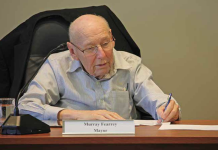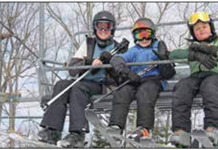A pitch to incorporate a scattering garden for cremations at St. Stephen’s cemetery has been shelved by Algonquin Highlands, with mayor Liz Danielsen feeling the idea “is so contrary” to the philosophy of the property’s
recently-established green burial section.
At a July meeting, deputy clerk Sarah Hutson said the township receives a high number of requests for cremations, noting they’ve become increasingly common across Canada. She referenced numbers from Statista, a global data platform, which put cremation rates nationwide at 76.9 per cent in 2023 – up from 47.7 per cent in 2000.
Cremains can be buried within designated cemetery plots at St. Stephen’s, St. Peter’s and Maple Lake – though there is no spot to scatter them.
Council opted against allowing cremains at the green burial section at St. Stephen’s last year. Ashes have a high pH level, similar to bleach, and a sodium content 200 to 2,000 times higher than plant life can tolerate making land it contacts sterile. Cremains are not biodegradable or compostable.
Hutson brought up a new eco-friendly technology some municipalities are utilizing that reduces cremains’ environmental footprint. Canadian firm AWAKE has developed a soil science that neutralizes ashes’ impact. She visited a site in Hamilton that has successfully implemented the system, suggesting it could be a good fit for
St. Stephen’s.
“Their patented product converts cremated remains into healthy organic earth, enriching soil microbes and plant nutrients while successfully storing carbon,” Hutson said.
Danielsen felt a better alternative was installing a columbarium, a structure that houses urns, at St. Stephen’s and investigate scattering gardens at St. Peter’s or Maple Lake, which was supported by deputy mayor Jennifer Dailloux and coun. Julia Shortreed.
“I’m really concerned with mixing philosophies… the [Haliburton Highlands Green Burial Society] has been so strong with their thoughts on cremation,” Danielsen said.
One of the founders of the local green burial society, Shirley Moore, passed away in March. She was the first to be buried in the new section at St. Stephen’s and her widower, Terry Moore, felt a scattering garden does not fit the vision his wife, or the wider Haliburton Highlands Green Burial Society, had for the space.
“Green burial is all about trying to deal with human remains in the most environmentally responsible manner
possible; cremains essentially damage anything they touch.
St. Peter’s cemetery was presented as a viable alternative, with Hutson saying she has “a general idea” of where a garden could be located. She noted the township will need to amend its bylaw for interments at the site.
Hutson was directed to engage with AWAKE on options for St. Peter’s.
Green burial unveiling
With the green burial section now active, Danielsen felt the clock was ticking on the township officially unveiling the space. An opening ceremony has been proposed, though council feel that should wait until a memorial stone has been installed.
At an Aug 14 meeting, Hutson said a local contractor has agreed to donate a stone from its quarry for the memorial project. Elected officials set aside $10,000 to pay for splitting and installation of the stone, a brass
plate to hold names of people buried there, and planting a mountain ash tree. Prep work is estimated to take six to eight weeks, with council scheduling an unveiling for Oct. 19 at 1 p.m.
The township is also investigating a BAO grant to pay for the installation of a columbarium.
Moore said the green burial society’s work is ongoing – the group is working with the BAO to allow for people to
purchase plots in advance, as is done with traditional burials. Currently, because plots are filled from front to back to allow for re-naturalization of the land – they can only be purchased when they’re needed.
“Planning is important… forcing people to buy and go through this while they’re grieving, we feel, is creating a major burden for people and, intentionally or not, is adding another barrier to green burials,” he added.
With green burial sections at St. Stephen’s and the Deer Lake cemetery in Highlands East, Moore said the next step is finding a way to bring the concept to Dysart et al and Minden Hills.
“We’re in the process of trying to figure out, now that we’ve got St. Stephen’s, where do we go from here,” he said.





